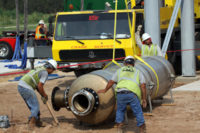The U.S. government is looking to its own buildings as a source for cutting carbon emissions with a new energy and climate performance standard. Additionally, federal officials announced a proposed rule that would eliminate energy-related emissions from new and renovated federal buildings.
The initiatives are aimed at achieving President Joe Biden’s goal of net-zero emissions from federal buildings by 2045, said Brenda Mallory, chair of the White House Council on Environmental Quality. The newly announced performance standard for existing federal buildings would require federal agencies to eliminate energy use and electrify equipment and appliances in 30% of their building space by 2030, Mallory said. It would impact 300,000 buildings. Achieving the standard would require a combination of electrification with deep energy retrofits, energy and water use reductions and facility improvements to maximize cost efficiency.
“That means optimizing the energy performance of the largest building owner and operator in the U.S., targeting a historic level of emissions at once,” Mallory said.
Additionally, the U.S. Dept. of Energy proposed a rule Dec. 7 requiring electrification of all new and renovated federal buildings. Starting in 2025, those buildings would be required to reduce their on-site emissions tied to energy consumption by 90% compared to 2003 levels, and “fully decarbonize” by 2030.
The rule would phase out on-site use of fossil fuels for uses such as heating, but would not penalize agencies for using fossil fuels for “mission-critical activities,” DOE officials said in an announcement. The proposed rule expands on a previous energy efficiency rule introduced in April that applies to new federal commercial and high-rise buildings.
U.S. Energy Secretary Jennifer Granholm said fossil fuels in federal buildings account for more than a quarter of the U.S. government’s greenhouse gas emissions. The rule would cut those emissions, while saving an estimated $8 million per year in costs. The change would also allow the government to “lead by example,” she added during a call with reporters.
“By making all new federal buildings clean and electrified, we will be setting a gold standard for new construction all across America,” Granholm said.
DOE plans to solicit comments on the proposed rule in the coming weeks, officials say. The department also scheduled a webinar for Jan. 5 to share more details about the scope of the proposal and an implementation timeline.
The existing building performance standard would not be formalized through the federal rulemaking process. Instead, Mallory said the plan fits into Biden's climate goals and would have a “durable effect” across administrations. The proposal is expected to reduce pollution, save taxpayer money and support job creation, she said.





